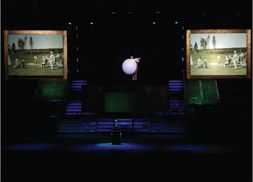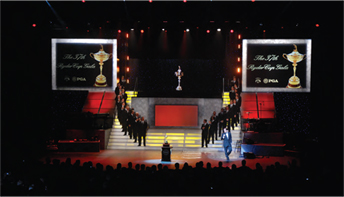NMR Staging & Events adds more depth to the 2008 Ryder Cup Gala
The 2400-seat Whitney Hall in Louisville’s Kentucky Center for the Performing Arts was the scene of this year’s Ryder Cup Gala, a mid-week event produced by the PGA of America prior to the beginning of the legendary Ryder Cup Matches. The black-tie event provides attendees with the official unveiling of participating teams, along with dinner and top-name entertainment.
This year’s event attracted around 1100 dignitaries from the world of golf and included live performances by country superstar Carrie Underwood and the tournament’s namesake, Samuel Ryder — who passed away in 1936.
Ryder appeared as a living, talking, and golf-ball hitting hologram that presented a rundown of the contest’s rich history, introduced the participating teams, and even appeared in a fully holographic chair before introducing master of ceremonies Dan Hicks and morphing into a giant, floating Ryder Cup trophy.
Production services were provided by the Princeton office of NMR Staging & Events, with Digital Illusions providing a Musion Eyeliner system for the holographic images.
The 2400-seat Whitney Hall in Louisville’s Kentucky Center for the Performing Arts was the scene of this year’s Ryder Cup Gala, prior to the beginning of the legendary Ryder Cup Matches. NMR Worldwide. “I felt the need to tell the story behind the Cup. Bringing Sam back to tell his own story wasn’t enough. We had originally wanted to do the hologram of the teams, but quickly realized this way was much more creative.
“Fortunately Whitney Hall has the capacity for such an event — from the rigging and height of the fly-rail systems to ample offstage space for control areas and downtown location. As far as systems go for a multilayered, high-profile event such as this, all video, staging, audio, and lighting had to be flexible enough to accommodate a large entertainment act and still incorporate the team reveal. The hologram itself presents challenges regarding the flow of the evening. Details like shot order, perspective, and so on are critical. Preproduction details showed that we needed to ‘invert’ the hologram system due to sightlines.”
The event’s audio system featured a DiGiCo CS-D5 digital console, which handled 24 inputs of video, wireless, recording, and playback, as well as outputs for both house and broadcast functions. The house system included 18 speakers per side, keeping sightlines clear and eliminating the need for delay lines to the two balconies. Digigram EtherSound technology kept the audio path in the digital domain by sending eight channels of EtherSound from the console to Nexo Geo D line arrays and CD18 sub low cabinets via Nexo 242 digital processors.

Ryder appeared as a living, talking, and golf-ball hitting hologram that presented a rundown of the contest’s rich history, introduced the participating teams, and even appeared in a fully holographic chair before introducing master of ceremonies Dan Hicks and morphing into a giant, floating Ryder Cup trophy. says Conrad, “sonic quality being primary, followed by flexibility and size. Sonically, onstage rejection and warmth were the main concerns.”
NMR’s video production and control system included gear from Sony, Folsom, and Grass Valley. Holographic images were projected on a 16-foot by 9-foot Da-Lite rear projection screen by a pair of Barco HD18 projectors. Switching was handled by Barco Folsom Screen Pro II’s and an Encore Controller, while cameras were switched by a Sony DFS 700. “Again, flexibility was key,” notes Conrad. “We went with the Screen Pro’s due to different resolutions of the outboard screens and the Musion system screen for the hologram. The Turbo’s provided the ability to sync-roll four units simultaneously and still have the capability of calling video cues at a rapid rate.”
The Musion system required a foiltype screen, based on the Peppers Ghost illusion, stretched tightly and virtually invisible, which, according to Conrad, required some delicate lighting decisions. “We had to be very careful not to reveal the screen and spoil the illusion,” he says, “so we used Chroma-Q LED fixtures to remove your focus of the support arch.” Lighting included over 400 automated and stationary fixtures hung from the theater’s existing grid.
According to Conrad, what made the project the most challenging was not Ryder’s “appearance,” but rather trying to reveal 26 of the world’s greatest golfers (12 players and a captain per team).
“This was certainly one of our most challenging events,” he says, “but, in the end, pre-production and system flexibility paid big dividends. Overall, the results were pretty amazing.”
Visit www.NMREvents.com for more information on NMR Staging & Events.











